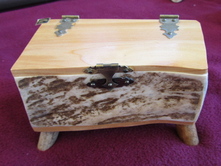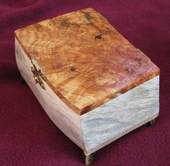Click to set custom HTML
Antler Buttons
Buttons vary in shape, color, size ...
Moose Antlers Living a solitary life in the northern woodllands is the moose, the largest of the deer family. During early spring the bull moose begins antler growth to replace those dropped off in late Fall.
At growth's end the peeling velvet is rubbed of on tree bark, branches and bushes. These buttons are cut from naturally shed antlers found in the wooded area of Alaska. |
Caribou AntlersBoth male and female caribou begin antler growth during early spring
to replace those droppped off in late Fall. When antler growth is complete the peelling velvet-cover is rubbed off on tree bark, branches and scrubs in preparation for the rut. This caribou antler art was made from naturally shred antlers found on the tundra in Alaska. |
Antler Boxes
Boxes varied in shape, texture, color, size...
The boxes shown are samples of boxes and their shapes.
Antlers, when cut, will take several weeks to twist and bend before the sides can be shaped.
The boxes shown are samples of boxes and their shapes.
Antlers, when cut, will take several weeks to twist and bend before the sides can be shaped.
Caribou Antler BoxBoth male and female caribou begin antler growth during early spring to replace those
dropped off in late Fall. When antler growth is complete the peeling velvet-cover is rubbed off on tree bark, branches and scrubs in preparation for the rut. This caribou antler art was made by David Hendren from naturally shred antlersfound on the tundra in Alaska. |
Moose Antler Box - Cedar Top & Bottom, Antler Tip FeetLiving a solitary life in the northern woodllands is the moose, the largest of the deer family.
During early spring the bull moose begins antler growth to replace those dropped off in late Fall. At growth's end the peeling velvet is rubbed off on tree bark, branches and bushes. This moose art is handmade by David Hendren from naturally shed antlers found in the wooded areas of Alaska. |








